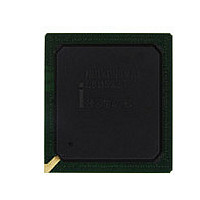NHIXP430AC Intel, NHIXP430AC Datasheet - Page 18

NHIXP430AC
Manufacturer Part Number
NHIXP430AC
Description
Manufacturer
Intel
Datasheet
1.NHIXP430AC.pdf
(24 pages)
Specifications of NHIXP430AC
Core Operating Frequency
400MHz
Mounting
Surface Mount
Operating Temperature (max)
70C
Operating Temperature (min)
0C
Operating Temperature Classification
Commercial
Lead Free Status / Rohs Status
Compliant
Available stocks
Company
Part Number
Manufacturer
Quantity
Price
Company:
Part Number:
NHIXP430AC
Manufacturer:
INTEL
Quantity:
170
Company:
Part Number:
NHIXP430ACT
Manufacturer:
AMCC
Quantity:
344
5.0
1.
Problem:
Workaround:
Status:
2.
Problem:
Workaround:
Status:
3.
Problem:
Intel
Specification Update
18
®
IXP43X Product Line of Network Processors
Intel XScale
Abort is Missed When Lock Command is Outstanding
A bus abort occurs on a code fetch while an instruction TLB or I-Cache lock Move to
Coprocessor from Intel XScale processor Register (MCR) command is outstanding. The
processor fails to abort and instead executes the instruction returned on the aborting
transaction. Parity errors are not affected. The bus abort may be due to an abort pin
assertion.
Branch flush after every I-TLB or I-Cache lock. For example, the following instruction
does this: SUB PC, PC #4;flush the pipe.
No Fix.
Aborted Store that Hits the Data Cache May Mark Write-Back Data as
‘Dirty’
When there is an aborted store that hits clean data in the data cache (data in an
aligned 4-word range that has not been modified from the processor since it was last
loaded from memory or cleaned), the data in the array is not modified (the store is
blocked), but the “dirty” bit is set. When the line is then aged out of the data cache or
explicitly cleaned, the data in that four-word range is evicted to external memory, even
though it has never been changed. In normal operation this is nothing more than an
extra store on the bus that writes the same data to memory that is already there.
The boundary condition where this might occur:
For this shared memory region, mark it as write-through memory in the processor page
table. This prevents the data from ever being written out as dirty.
No Fix.
Performance Monitor Unit Event 0x1 Can be Incremented
Erroneously by Unrelated Events
Event 0x1 in the performance monitor unit (PMU) can be used to count cycles in which
the instruction cache cannot deliver an instruction. The cycles counted should be only
those due to an instruction cache miss or an instruction TLB miss. The following
unrelated events in the processor also causes the corresponding count to increment
when event number 0x1 is being monitored:
1. A cache line is loaded into the cache at Address A.
2. Another master externally modifies Address A.
3. A processor store instruction attempts to modify A, hits the cache, aborts because
4. The cache line at A then ages out or is explicitly cleaned. The original data from the
• Any architectural event (for example, IRQ, data abort)
• MSR instructions that alter the CPSR control bits
• Some branch instructions, including indirect branches and those mispredicted by
• CP15 MCR instructions to registers 7, 8, 9, or 10 that involve the instruction cache
of MMU permissions, and is backed out of the cache. That line normally is not
marked dirty, but because of this errata, is marked as dirty.
location A is evicted to external memory, overwriting the data written by the
external master. This happens only when software is allowing an external master to
modify memory, that is, write-back or write-allocate in the processor page tables,
and, depending on the fact that the data is not dirty in the cache, to preclude the
cached version from overwriting the external memory version. When there are any
semaphores or any other handshaking to prevent collisions on shared memory, this
is not a problem.
the BTB
or the instruction TLB
®
Technology Errata Descriptions
5.0 Intel XScale
Order Number: 316847; Revision:
®
Technology Errata Descriptions
December 2008
005US












